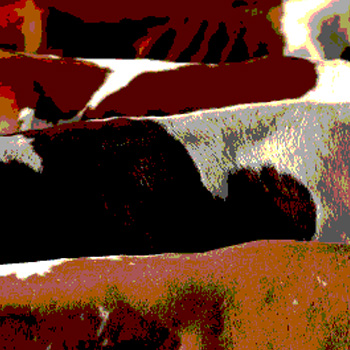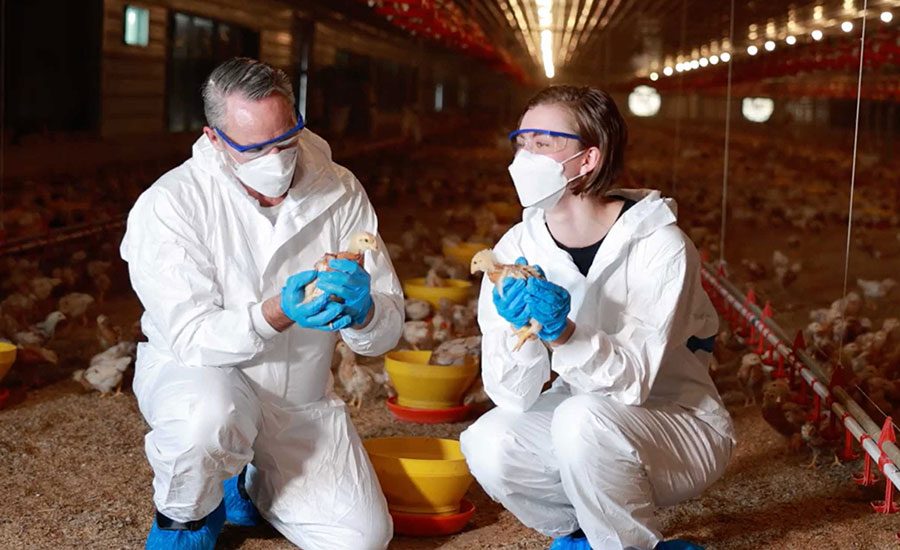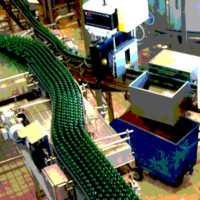To ensure the highest food safety and enhance quality, food processors must work on both preventing and controlling the entrance and presence of pathogenic microorganisms into their products and facilities. A large source of pathogenic microorganisms entering a meat processing plant is the fecal matter present in the animal’s hide. HOCW Edge is a mild alkaline detergent effective in removing debris from the hide and thus decreasing the hide’s microbial load by at least 99%.
Background
Food safety and the prevention of food related outbreaks are a priority for food producers, public health officials and consumers. The economic burden of foodborne illnesses in the U.S. has been estimated to be $14 billion per year.[1] As food processing operations become larger, the need for consistent and reliable hygienic measures increases. To that extent, food production facilities focus on both preventing and controlling the presence of foodborne pathogens in their products. The Institute of Medicine has made recommendations on microbiological criteria specific for each phase of production[2] as guidance to manufacturers on improving the safety of the food they produce.
The U.S. Department of Agriculture’s Food Safety and Inspection Service (USDA FSIS) maintains oversight of safe food production. In addition, products for intrastate production and consumption can be inspected by state agencies and audited by USDA.[3] FSIS began Hazard Analysis and Critical Control Points (HACCP)-based inspections of beef plants in 1997. This program sets performance standards and requires the processors to follow them. Food processing facilities are thus required to conduct hazard analysis related to microbial contamination as a part of their HACCP plan (9 CFR 417.2). The criteria for process control verification is defined as the absence of generic Escherichia coli in fresh meat (with a method sensitivity of 5 cfu/cm2 of carcass surface) as a means to evaluate processing controls efficacy in preventing or removing fecal contamination from the carcass. Similarly, the standard for pathogen reduction is based on a qualitative assay for the presence or absence of Salmonella spp. (9 CFR 310.25). More recently, the U.S. Food and Drug Administration’s Food Safety Modernization Act (FSMA) was signed into law on January 2011. It takes HACCP prerequisite programs and concepts a step ahead by focusing on preventing contamination instead of simply responding to it or controlling it.
Bacteria present on hides, hooves and other external surfaces of the cattle at the time of slaughter are potential sources of contamination of the carcass and subsequently of all derived beef products. The Code of Federal regulations acknowledges under 9 CFR 310.25 that “fecal contamination of carcasses is the primary avenue for contamination by pathogens.”[3] Thus, in alignment with FSMA vision, an intervention step to reduce microbial contamination in hides is paramount. Several formal in vitro and in vivo studies have shown that reducing microbial load in the hide, improves the efficacy of other pathogen interventions during the processing stage[4] and reduces the probability of cross-contamination of carcasses and primal during processing. Fecal matter and other soils found in hides are a hazard that needs, and can be, controlled by the beef processing establishment and must be addressed in the facility’s HACCP plan. This concept covers not only contamination of the meat but also cross-contamination within the processing facility. Although current research suggests that pre-harvest interventions such as vaccines, probiotics or diet can reduce pre-harvest fecal shedding in cattle,[5] neither intervention would completely eliminate this shedding or eliminate other microbial sources present on hides.
The beef industry and the associated chemical industry have devoted time and resources on defining sanitary processing practices by chemically or physically treating the carcass during slaughter, dressing, and processing. These practices help eliminate the presence of microorganisms such as E. coli O157:H7 (considered an adulterant by FSIS, and thus having a zero tolerance policy), reduce the overall microbial load in beef products and prevent cross-contamination. Microbial control strategies range from facility design and Sanitation Standard Operating Procedures (SSOPs) to direct treatment (physical or chemical) of the food. Although several technologies exist that are capable of effectively inactivating microorganisms at different stages of the beef production process, many of these technologies also affect the sensory properties of the beef product, reducing its quality. An effective treatment should demonstrate a measurable reduction in microbial load without presenting any residue concerns, organoleptic effects or negatively impacting worker safety or the environment. The efficacy of a cleaning or sanitizing step is impacted by the use conditions (i.e., concentration, time, temperature, etc.). Excessive chemical or physical treatment of products can result in lower quality and undue economic burden to the manufacturer without an increase in product safety.
HOCW Edge is recommended as hide wash to be used immediately after slaughtering for the removal of debris from hides. As noted before, debris is a potential carrier of biological, chemical and physical hazards. Although interventions such as water washes are economical and remove some of the debris present on the hide and hooves, the objective of this study was to demonstrate how the usage of HOCW Edge increased the efficacy of the hide wash step. HOCW Edge reduces the dirt and pathogen load of each carcass, and minimizes the possibility of cross contamination to other carcasses. In addition, it facilitates the job for subsequent intervention steps during the dressing and further processing by providing a lower bioburden to be controlled.
In Vitro Cleaning Studies
E. coli is a Gram-negative bacterium that is ubiquitous in the intestines of healthy cattle. As such, it is an excellent indicator of fecal contamination. It persists for days in several environments such as soil, water and manure.[3] Several strains of E. coli, including O157:H7, are associated with disease in humans. A low dose is capable of causing severe health problems in humans.
For the present study, fresh beef hides were collected from a slaughtering facility and cut into 12 × 12-in pieces. Each piece was individually packaged and frozen for transportation to the laboratory. Prior to the test, the hides were thawed and cut into 4 × 4-inch pieces.
 Individual colonies of E. coli ATCC 10536 were grown in tryptic soy broth (TSB) for 48 h at 37 °C, prior to subculturing in TSB for 18 h at the same temperature. The cell density of the subculture was adjusted to ca. 1.0+06 cfu/ml. Each piece was inoculated with 1 ml of cell suspension in 1 g of pre-sterilized manure resulting in a measured cell density of 8.0 × 105 cfu E. coli ATCC 10536 per hide piece. Each hide was allowed to rest for 20 min at room temperature (22 °C), to allow for absorbance of the slurry, prior to being sprayed for 30 sec at 40 psi from a distance of 4 inches from the nozzles (Figure 1). The treatment solutions were either HOCW Edge at a dose of 0.5 or 1 ounces per gallon tap water. Treatments were applied at 25 °C or 50 °C in either tap water or hard water (300 ppm CaCO4). Additional exposure times, pressures, temperatures and distances from the nozzles were evaluated (data not shown).
Individual colonies of E. coli ATCC 10536 were grown in tryptic soy broth (TSB) for 48 h at 37 °C, prior to subculturing in TSB for 18 h at the same temperature. The cell density of the subculture was adjusted to ca. 1.0+06 cfu/ml. Each piece was inoculated with 1 ml of cell suspension in 1 g of pre-sterilized manure resulting in a measured cell density of 8.0 × 105 cfu E. coli ATCC 10536 per hide piece. Each hide was allowed to rest for 20 min at room temperature (22 °C), to allow for absorbance of the slurry, prior to being sprayed for 30 sec at 40 psi from a distance of 4 inches from the nozzles (Figure 1). The treatment solutions were either HOCW Edge at a dose of 0.5 or 1 ounces per gallon tap water. Treatments were applied at 25 °C or 50 °C in either tap water or hard water (300 ppm CaCO4). Additional exposure times, pressures, temperatures and distances from the nozzles were evaluated (data not shown).
After the spray application, the entire surface of the hide was swabbed with a sterile sample collector. Swabs were placed in a neutralizing solution to halt the activity of the chemical, maintain bacterial cell integrity and prevent further cell damage. Bacterial recovery through the swabbing technique was validated on inoculated hides not subject to chemical treatment.
Cell recovery from each of the treatments was calculated using the most probable number (MPN) technique. The values obtained from each treatment were compared to that obtained from inoculated hides that had not received either water or chemical treatment.
Results
.jpg) Microbial counts from the treated hides clearly indicate that E. coli removal from hides was more effective when water was dosed with 1 ounce/gallon HOCW Edge (Figure 2). Removal was 1.5-log higher increasing from 87.7% to 99.5%.
Microbial counts from the treated hides clearly indicate that E. coli removal from hides was more effective when water was dosed with 1 ounce/gallon HOCW Edge (Figure 2). Removal was 1.5-log higher increasing from 87.7% to 99.5%.
 Higher microbial removal is also achieved independent of the water temperature. While the experiment presented in Figure 2 was performed at 25 °C, at temperatures twice as high (50 °C), HOCW Edge is able to remove approximately 1-log more microorganisms from the hide (Figure 3). Similarly, in the presence of hard water at 600 ppm as CaCO4, HOCW Edge performs better than water alone, even at lower active doses (Figure 4). Thus within a variety of dosage, temperature and water hardness conditions, HOCW Edge provides more efficient microbial removal from hides.
Higher microbial removal is also achieved independent of the water temperature. While the experiment presented in Figure 2 was performed at 25 °C, at temperatures twice as high (50 °C), HOCW Edge is able to remove approximately 1-log more microorganisms from the hide (Figure 3). Similarly, in the presence of hard water at 600 ppm as CaCO4, HOCW Edge performs better than water alone, even at lower active doses (Figure 4). Thus within a variety of dosage, temperature and water hardness conditions, HOCW Edge provides more efficient microbial removal from hides.

Such efficient removal was achieved without affecting the integrity of the hide. As seen in Figure 5, visible debris removal after treatment with either water or HOCW Edge is equivalent in extent. In neither case does the treatment result in hair loss, discoloration or other perceivable damage to the hide. This is due to the mildness of the HOCW Edge formulation, which at the dose tested provides 0.25% total alkalinity. However, as discussed before, bacterial removal with HOCW Edge is more efficient than with water alone.

The conditions shown above are optimal for the test set up and similar to those found in the field. Increases in pressure, exposure time, or proximity to the spray nozzles, did not result in significantly higher microbial removal (data not shown). Nonetheless, none of the other conditions tested, including exposure times of up to 1 min and spray pressures up to 80 psi, negatively affected hide integrity.
Conclusions
While intact skin presents a barrier against pathogen contamination of the meat, it is practically impossible to avoid transfer of pathogens from the hide to interior surfaces during slaughtering and dressing. Although testing of carcass for microbial burden is not mandatory, its implementation brings awareness of gaps in the control processes. It also provides important information on the microbiological quality of each cattle lot and generates a baseline of the potential microbial burden entering the plant. All these factors provide opportunities for the generation of continuous improvement measures, resulting in a higher quality product and improved public safety. As an example, since the implementation of the HACCP rule in meat processing plants there has been a 40% decline in foodborne illnesses as documented by the U.S. Centers for Disease Control and Prevention from 2001 to 2010.[6]
The in vitro testing results presented here demonstrate the benefits of an effective intervention on carcasses prior to dressing that does not affect hide quality. This laboratory data has been confirmed by reports from current users of HOCW Edge confirming in average 99% lower microbial counts on hides washed immediately following exsanguinations. Additionally, the efficacy of microbial removal by HOCW Edge was not affected by the temperature of the treating solution, suggesting potential energy savings when using this product.
The sources of microbial contamination in a food processing plant are varied and abundant. Deficient process control practices or procedures result in uncontrolled risk. High manure load is one of those risks that can and should be controlled. Pathogen control in food processing plants cannot be achieved in a single intervention step or with a single intervention strategy. A comprehensive pathogen control plan must include a combination of best practices both over the meat product but also in combination with the SSOPs. This plan can yield cumulative effects that are more than additive as each step in controlling or reducing the presence of pathogens reduces the challenge for subsequent steps, thus incrementally reducing risk and increasing the likelihood of success.
Carolina Mateus, Ph.D., is with DeLaval Cleaning Solutions, a division of DeLaval Manufacturing. For more information, please visit delavalcleaningsolutions.com/.
References
1. Batz, M.B., Hoffmann, S. and Morris, J.G., Jr. 2011. Ranking the risks: The 10 pathogen-food combinations with the greatest burden on public health. Emerging Pathogens Institute, University of Florida.
2. Institute of Medicine (IOM). 2003. Scientific criteria to ensure safe food. National Academy Press, Washington D.C.
3. National Research Council. Committee on the Review of the use of Scientific Criteria and Performance Standards for Safe Food. 2003. Scientific criteria to ensure safe food. National Academy of Sciences.
4. National Cattlemen’s Beef Association. 2007. Special report: Beef safety research focuses on pre-harvest opportunities. Issues update.
5. FSIS. (2010). Pre-harvest management controls and intervention options for reducing Escherichia coli O157:H7 shedding in cattle. USDA.
6. Center for Science in the Public Interest. 2013. Outbreak alert! 2001–2010. CSPI.
Carcass Washing: First Line of Defense on Beef Pathogen Intervention Strategies

Looking for a reprint of this article?
From high-res PDFs to custom plaques, order your copy today!




